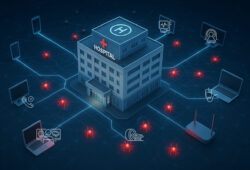The potential & pitfalls of these devices
Wearable technology is revolutionizing care for heart conditions, epilepsy, diabetes and sleep apnea. It empowers people to participate in their own care and gives patients and clinicians access to more health metrics and data. However, these innovative devices also come with risks and challenges that shouldn’t be ignored. Here are some of the potential benefits and pitfalls of wearable tech.
Heart health
Wearable devices are making it easier than ever for people to monitor their cardiac health in their daily lives. This can give people insight into potential problems and the data to back it up, which they can share with their doctors.

For example, wearables are proving useful in helping to identify supraventricular tachycardia (SVT), a type of arrhythmia in which episodes might only happen a few times a year, making diagnosis challenging. While SVT episodes can be sporadic, they can significantly impact a person’s quality of life, and, in rare cases, can be dangerous.
“Traditionally, we have gone into an ablation for SVT just based on a patient’s description of symptoms consistent with SVT—which means we’re putting someone into an invasive test without necessarily having a documented arrhythmia,” says HealthTrust Physician Advisor Genevieve Everett-Sigwalt, M.D., an electrophysiologist at the University of Pittsburgh Medical Center. “But now that I have so many more patients with wearable technology monitoring heart rhythms, it’s more the exception than the rule that I take someone to the lab where I haven’t documented their SVT, as reported by their smartwatch.”
Inpatient monitoring

Wearable tech isn’t just for consumer or home use. HealthTrust Physician Advisor Filip Roos, M.D., Division Chief Medical Officer at HCA Healthcare Mountain Division, is excited about the potential for wearable devices to improve inpatient monitoring, especially in reducing the 30-day mortality rate in perioperative care. “It’s the undetected, often abnormal vital signs that can cause a cardiac or kidney injury, and ultimately even death,” he says. For example, transient low oxygen and low blood pressure, which are linked to poor outcomes, can be missed during routine post-op vital sign checks.
“I see wearables as a huge opportunity for surgical patients to be monitored closely so we can act on information quickly, rather than waiting for the next blood pressure check,” says Dr. Roos.
Moving to more regular use of wireless pulse oximeter and ECG monitors, along with wearable or wireless blood pressure monitors, would allow patients to be more mobile and decrease their risk of developing non-ventilator healthcare-associated pneumonia.
Dr. Roos also sees a role for wearable tech in improving the alarm function of monitors. “We have a lot of monitors that patients are attached to that generate a wealth of information. The difficulty is in distinguishing noise and misleading or unnecessary alarms from true alarms,” he says. “I think in the future, the technology will be able to collect the data, analyze it, and sense or detect meaningful changes rather than artificial alarms. With the wealth of data we’ll be able to collect moving forward, AI can be smart enough to predict bad events before they happen, which is always better in terms of outcomes and patient safety.”
Potential pitfalls
While the benefits and promise of wearables are undeniable, they also come with risks and concerns around safety and regulation, accuracy and data privacy.
Some consumer wearables have received clearance from the U.S. Food and Drug Administration (FDA) for specific features—for example, Apple Watch and Fitbit have been cleared to identify atrial fibrillation (Afib). But overall, consumer wearables are less regulated and undergo less testing than medical-grade devices do. In early 2024, the FDA issued a warning about smartwatches and smart rings manufactured by dozens of companies that wrongly claim to measure blood glucose levels without piercing the skin. Misleading and unsubstantiated claims such as these can lead to dangerous and potentially life-threatening situations.
Reliability & accuracy
Giving people greater insight into their heart health is a positive development, says Dr. Everett-Sigwalt, but she has concerns that “these technologies are getting ahead of themselves.”
“Wearable tech at this point is not set up with robust enough software to accurately diagnose arrhythmias. Any time the Apple Watch sees an irregular rhythm, it sends the wearer a notification that they have atrial fibrillation, and often that’s not the case,” explains Dr. Everett-Sigwalt. She reports the same problem exists with implantable monitors such as loop recorders. The software currently being used with these devices is not yet accurate enough to distinguish between types of arrhythmias, requiring a physician to review and interpret the data.
And while wearables can aid in the early diagnosis of conditions such as Afib—and lead to treatment that prevents a stroke or heart failure—false positives can lead to unnecessary testing and risk overwhelming the healthcare system. “People who wouldn’t have been seeking medical care or evaluation by a cardiologist now think they have an arrhythmia because their watch told them they did,” adds Dr. Everett-Sigwalt.
Data privacy
One of the most cited concerns with wearable tech is around data protection and patient privacy. “Ensuring the security and privacy of the data is paramount. How do you secure that wireless transmission of information while still having it readily available to the systems that use it?” asks Dr. Roos.
These devices not only track health data, but also collect other personal information such as name, gender, age and geographic location. Depending on its features or connectivity with other apps, data such as purchase history and online browsing behavior might also be captured. This data is often stored in the cloud and shared with third parties, such as other apps and advertisers. How this data is being used, and who has access to it, is not always clear. Many are concerned that personal data could be sold or used without consent. Data breaches and cyberattacks are also concerns, putting people at risk of identity theft, financial loss and other crimes.
These risks and pitfalls will need to continue to be identified and addressed to keep people safe while allowing wearable technology to reach its full potential.
“The future of wearable technology is in the software behind it, meaning ultimately the artificial intelligence that has to be utilized in analyzing the data from wearable technologies to make it useful and actionable,” says Dr. Roos. “Only the future will reveal how far this will go, and that’s going to be driven by collaboration between biology and computer science.”
Visit Technology & Innovation for more stories about the intersection of healthcare and technology.
Share Email AI, Cybersecurity, Innovation, Q3 2024




